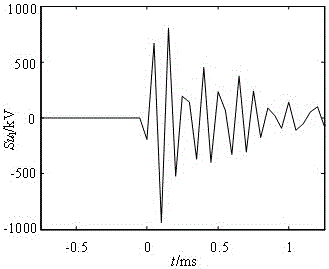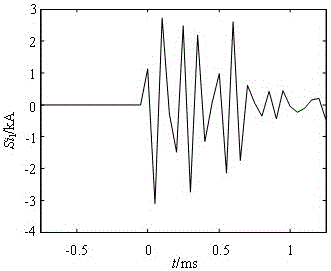A Sequence Overlap Differential Directional Protection Method for Transmission Lines with Static Synchronous Series Compensators
A series compensation, static synchronization technology, applied in the direction of emergency protection circuit devices, electrical components, etc., can solve the problem of difficult identification of line faults, and achieve the effect of reliable and effective criteria
- Summary
- Abstract
- Description
- Claims
- Application Information
AI Technical Summary
Problems solved by technology
Method used
Image
Examples
Embodiment 1
[0035] Example 1: 500kV line with static synchronous series compensator such as figure 1 shown. The line parameters are as follows: the total length of the line is 150km for the PM section, 150km for the MN section, and 220km for the NQ end. Fault location: A single-phase ground fault occurs at the MN section 1km away from the M terminal. Ground impedance 0Ω, fault time 0.464s, initial fault angle , the sampling rate is 20kHz.
[0036](1) According to the line-mode voltage and current transient data obtained in step 1 in the manual,
[0037] (2) According to step 2 in the instruction manual, perform 4th-order differential calculation on the line-mode voltage and current transient data obtained in step 1 to obtain the voltage and current differential sequence and their product differential sequence curve, such as figure 2 , 3 , 4 shown.
[0038] (3) According to formula 4 and formula 5 in step 4 in the description Figure 4 To judge, by sign[SP l (k)]=-1 shows that th...
Embodiment 2
[0039] Example 2: 500kV line with static synchronous series compensator such as figure 1 shown. The line parameters are as follows: the total length of the line is 150km for the PM section, 150km for the MN section, and 220km for the NQ end. The grounding impedance is 10Ω, the fault time is 0.454s, the initial fault angle is -90°, and the data sampling rate is 20kHz. A single-phase ground fault occurs at a distance of 149km from the M terminal in the MN section.
[0040] (1) According to the line-mode voltage and current transient data obtained in step 1 in the manual,
[0041] (2) According to step 2 in the instruction manual, perform 4th-order differential calculation on the line-mode voltage and current transient data obtained in step 1 to obtain the voltage and current differential sequence and their product differential sequence curve, such as Figure 5 , 6 , 7 shown.
[0042] (3) According to formula 4 and formula 5 in step 4 in the description Figure 4 To judge, ...
Embodiment 3
[0043] Example 3: 500kV line with static synchronous series compensator such as figure 1 shown. The line parameters are as follows: the total length of the line is 150km for the PM section, 150km for the MN section, and 220km for the NQ end. The grounding impedance is 0.1Ω, the fault time is 0.454s, the initial fault angle is -90°, and the data sampling rate is 20kHz. A single-phase ground fault occurs at a distance of 75km from the M terminal on the PM section.
[0044] (1) According to the line-mode voltage and current transient data obtained in step 1 in the manual,
[0045] (2) According to step 2 in the instruction manual, perform 4th-order differential calculation on the line-mode voltage and current transient data obtained in step 1 to obtain the voltage and current differential sequence and their product differential sequence curve, such as Figure 8 , 9 , 10 shown.
[0046] (3) According to formula 4 and formula 5 in step 4 in the description Figure 4 To judge,...
PUM
 Login to View More
Login to View More Abstract
Description
Claims
Application Information
 Login to View More
Login to View More - R&D
- Intellectual Property
- Life Sciences
- Materials
- Tech Scout
- Unparalleled Data Quality
- Higher Quality Content
- 60% Fewer Hallucinations
Browse by: Latest US Patents, China's latest patents, Technical Efficacy Thesaurus, Application Domain, Technology Topic, Popular Technical Reports.
© 2025 PatSnap. All rights reserved.Legal|Privacy policy|Modern Slavery Act Transparency Statement|Sitemap|About US| Contact US: help@patsnap.com



